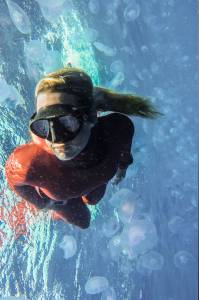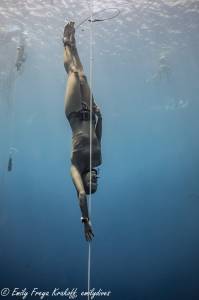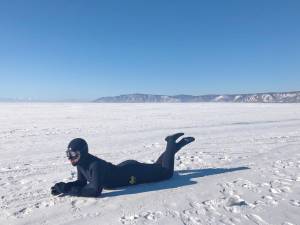Reflections on new generation wetsuits
The increasing (but often unprofessional) demand of most divers and spearfishers for softer, multi-purpose and easy-to-wear wetsuits led neoprene manufacturers to produce materials which are extremely soft and stretchy. As a consequence, this products made possible the creation of excellent wetsuits, very elastic and comfortable like a glove, like a new skin.
All these fantastic materials have many advantages but present also some disadvantages or better hidden Achille’s heels. We will now analyse the second ones very closely.
- Limited resistance against compression (caused by water pressure). This implies loss of buoyancy underwater (particularly during apnea diving) at middle depth and after an intensive and prolonged use causes a definitive and irreversible loss of thickness which vanishes the fundamental insulating qualities of neoprene.
- Fragility. Single lined (smoothskin or – worse – cell) wetsuits reveal their extreme fragility in case of abrasions, tears and impact with rocks. For this reason you need to pay much more attention also during dressing.
- The third defect is indirect in the sense that it does not belong to the material itself but derives from the faults of the so-called “stylists”. Frankly speaking, new materials are very soft and stretchy, and wetsuit designers who don’t care for this will have to adopt some tricks to conceal the negative sides of their unperfect wetsuits. And they simply will make very tight wetsuits, which will look perfect like a glove, having no air pockets or folds.


This last reason represents the most serious problem for some vendors (but first of all for their clients). The major causes for this are described as follows.
A wetsuit made with today’s super-soft materials which does not make creases very often means that it is overstretched but also its thickness results a lot thinner than it really is. As a consequence, its surface is too stretched and in case of smoothskin wetsuits every little cut can become a serious tear; repairs will be more complicated and sizing weaker, and wetsuits lose thermal insulation because of reduction of thickness only after a short period of time. Furthermore, many tests and controls on neoprene and various products have shown and confirmed that wetsuits which adhere too much to the body seem initially more comfortable but only after a few hours in the water reveal their problems and don’t allow a good ventilation.
This can sound like a paradox, but the so called “hard” wetsuits which were produced some years ago are still nowadays so much requested by many deep sea divers and spearfishers. They are to be worn very tight because their hardness makes the “suction effect” difficult and thickness doesn’t modify with pressure.
On the other hand modern wetsuits have to be built perfectly around the human body, not being overstretched but only laid down on the body. If they are worn without water (or worse under the shower), their extreme softness will make them seem very large because the air or the shampoo which remain between the skin and the material tend to move the wetsuits.
This problem is resolved by means of the special “air depletion” technique (presuming there is not too much shampoo between neoprene and the body) to be applied exclusively in the water (in the sea). And this is easily explained: just enter the water at a depth of two meters, strike an oblique position on one side and raise the arm on the same side. The raised arm will act as a chimney and will let air easily flow out through the cuff. At this point the wetsuit adheres perfectly to the body like a suction cup. Now you can have a perfect wetsuit which follows every single movement of the body without letting water come in and being too stretched and making breathing easier while exercising an optimal thermal insulation.


